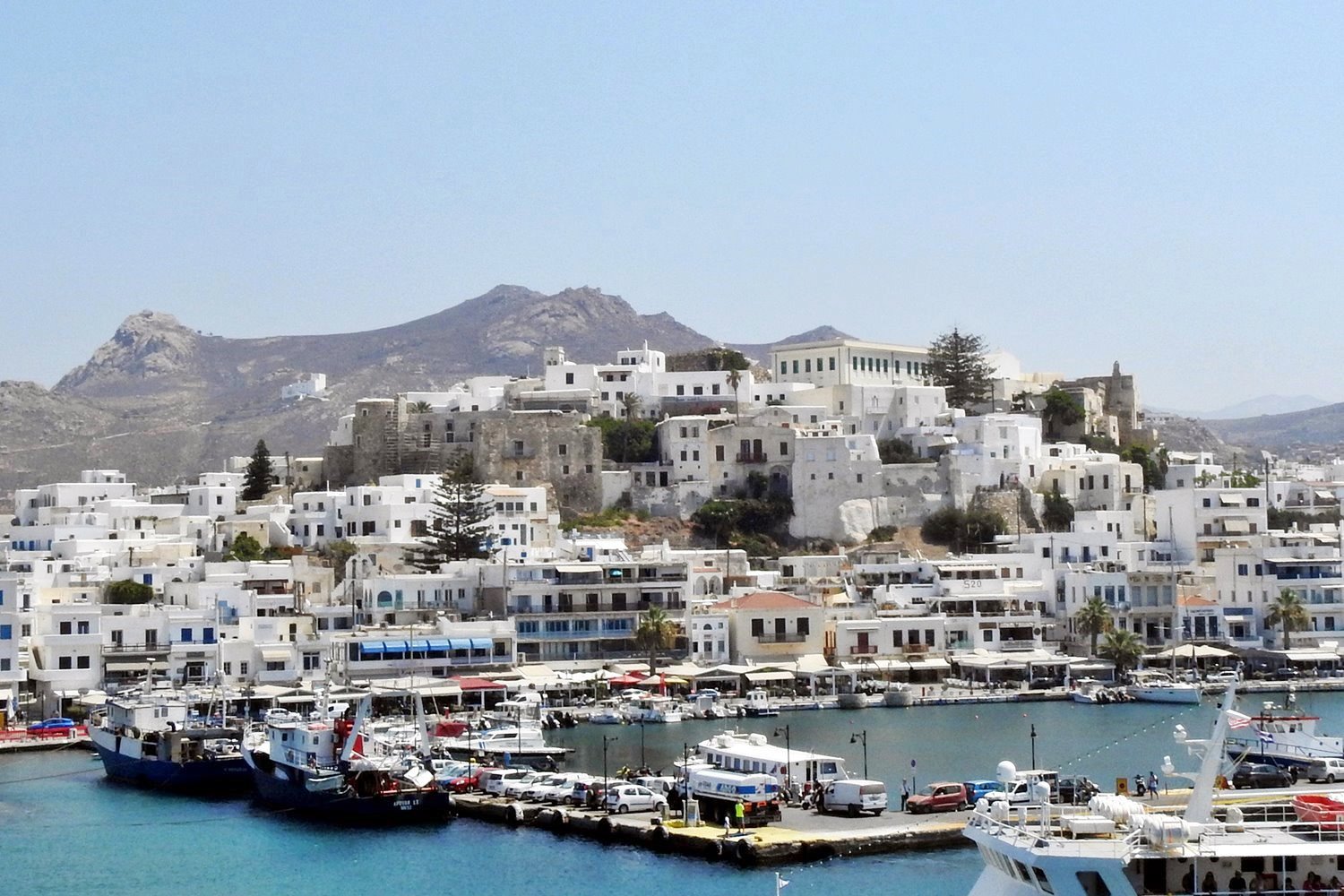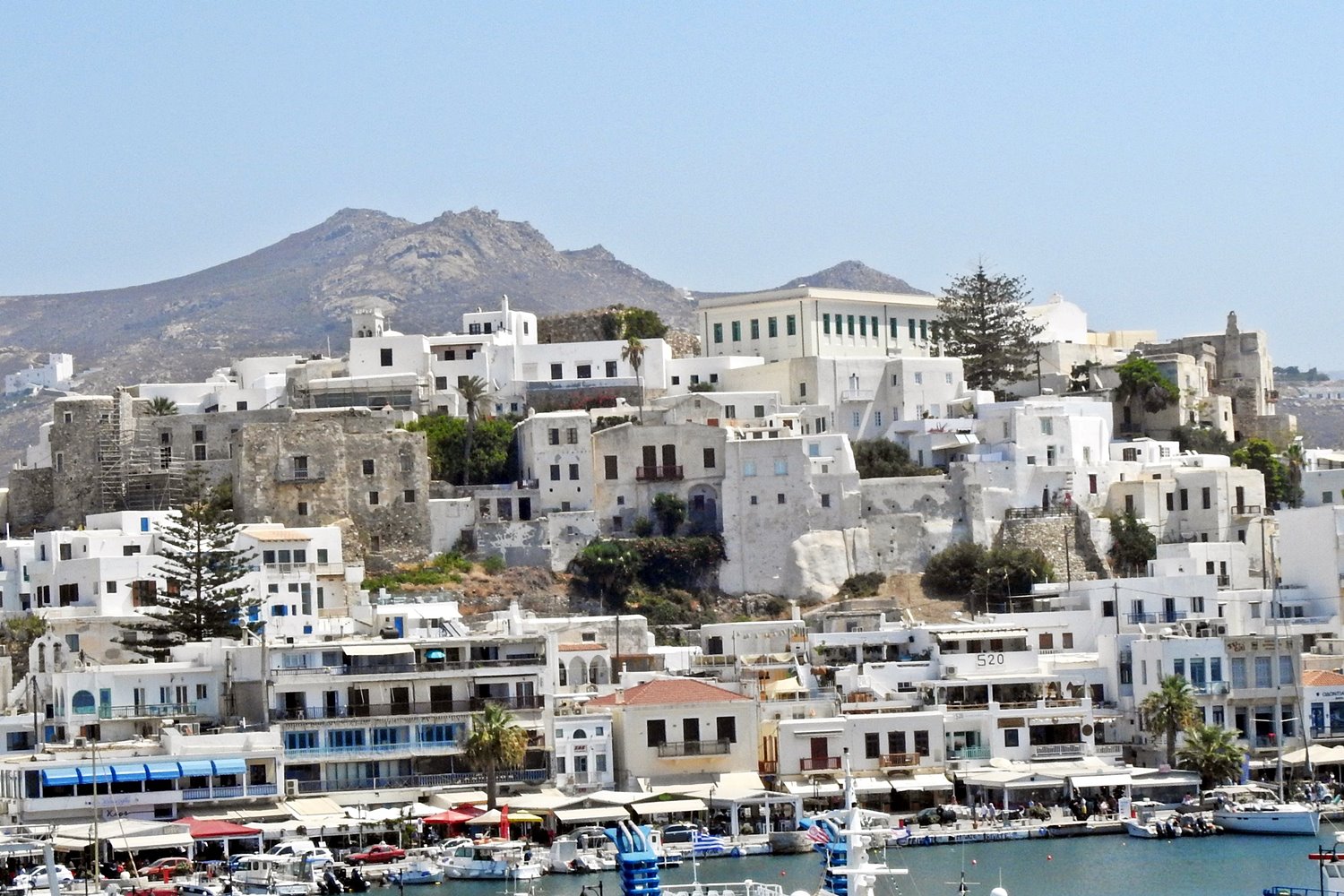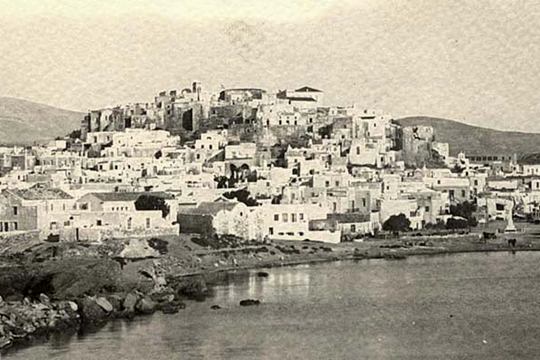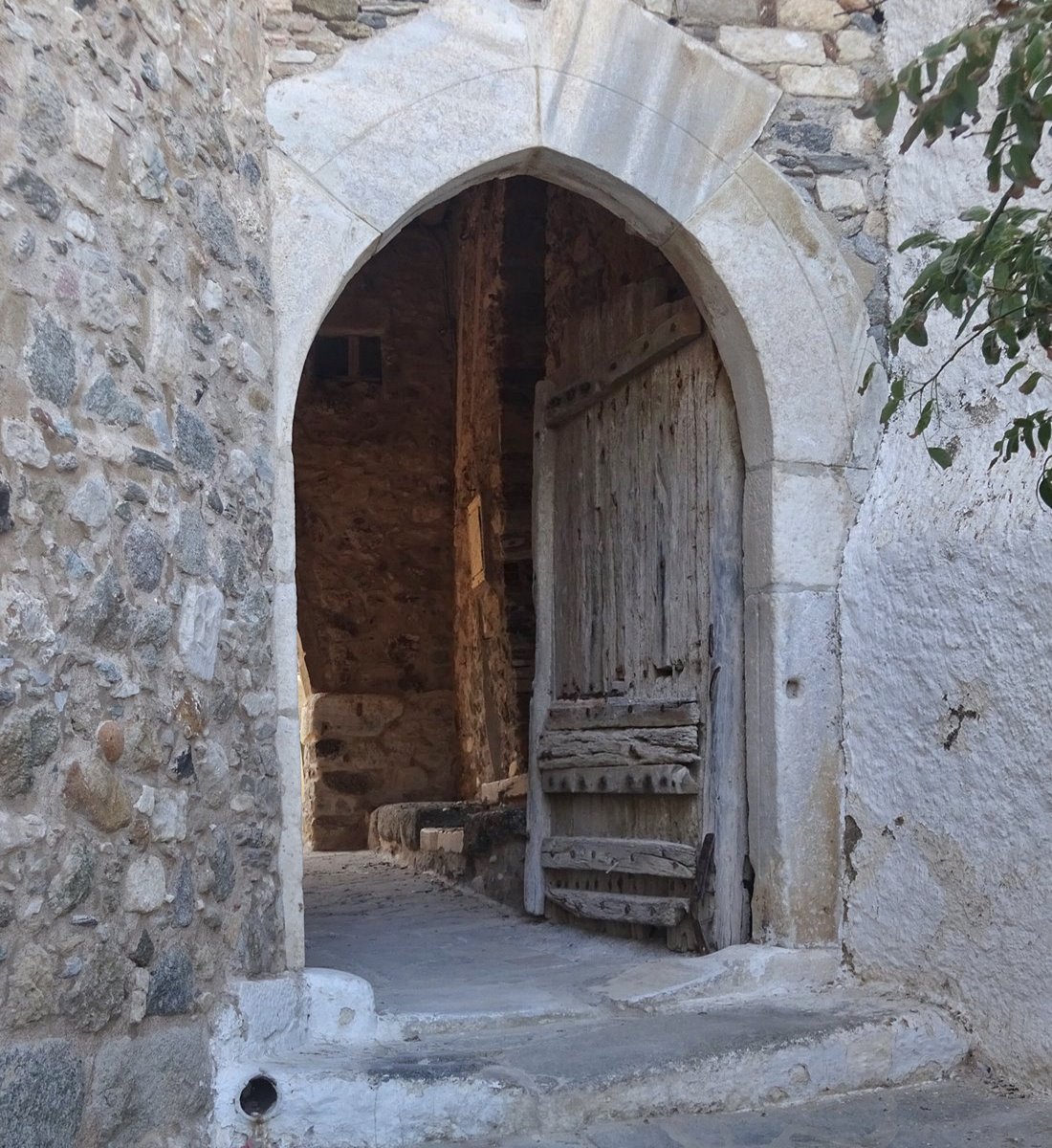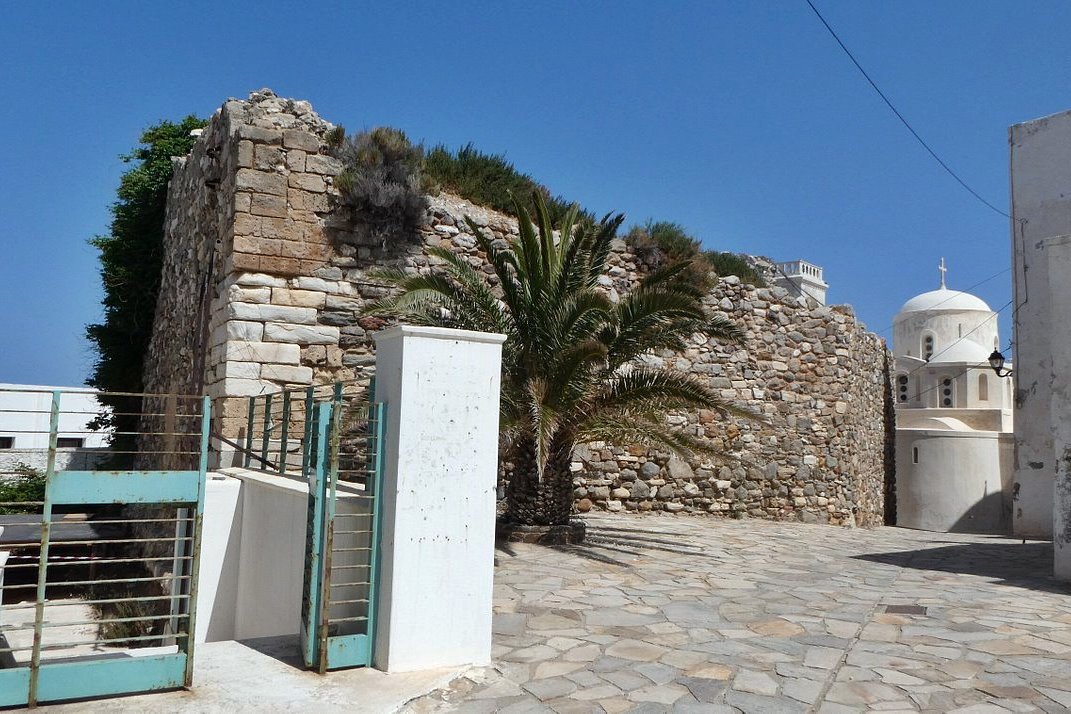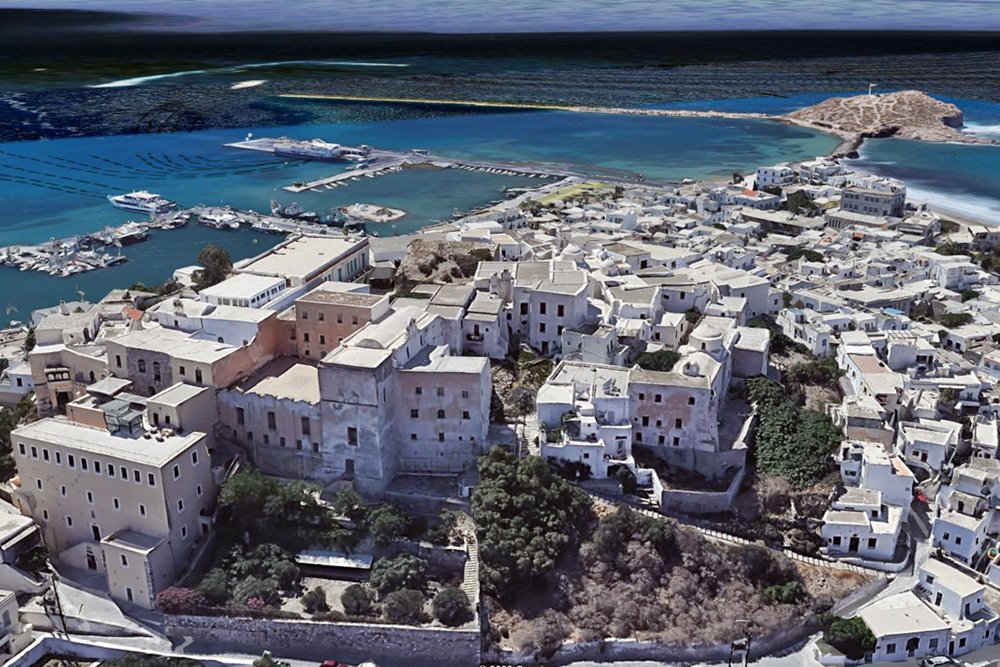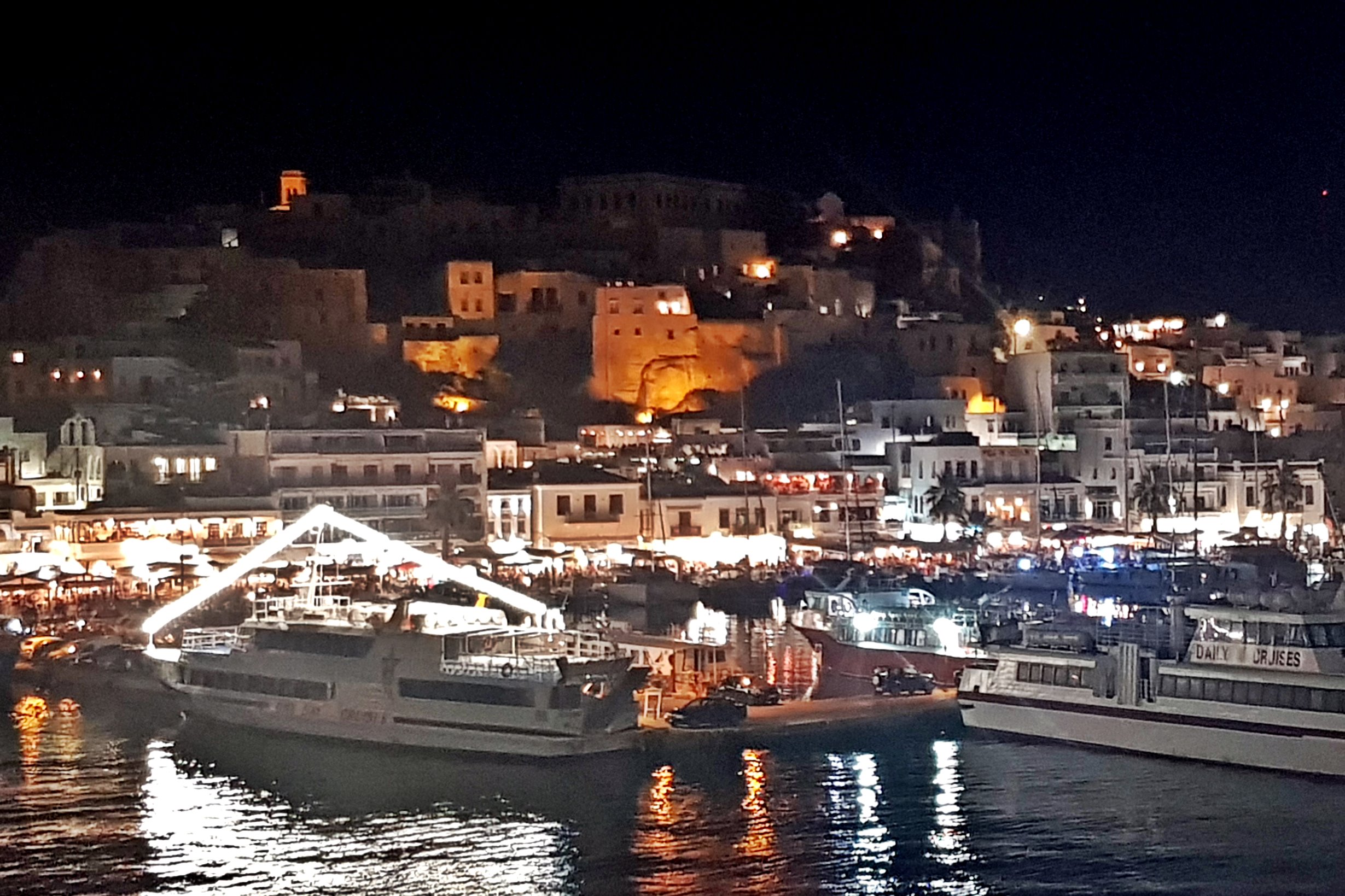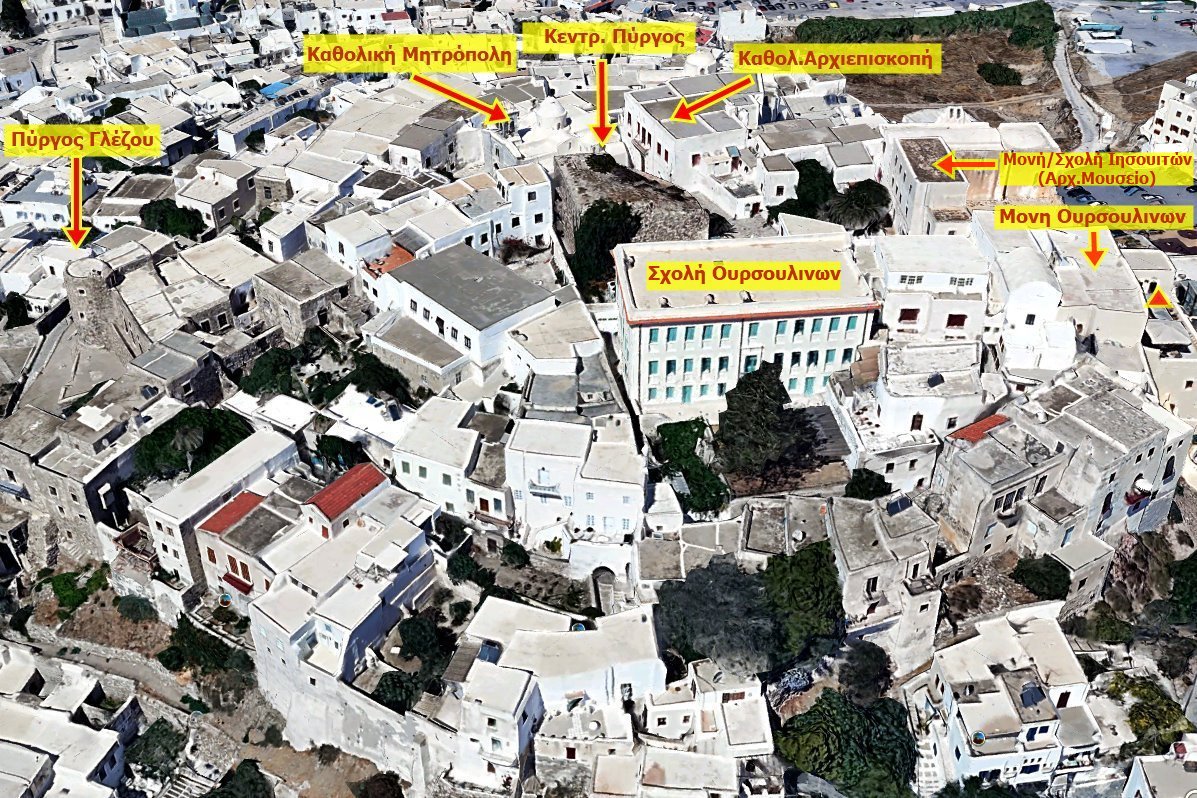Chora, Naxos, Cyclades,South Aegean
Naxos Castle
| Location: |
| Chora, Naxos |
| Region > Prefecture: | 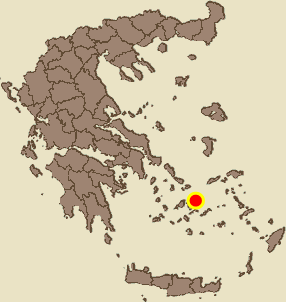 |
| South Aegean Cyclades | |
| Municipality > Town: | |
| City of Naxos • Chora | |
| Altitude: | |
| Elevation ≈ 30 m |
| Time of Construction | Origin | |
| after 1207 | VENETIAN |
|
| Castle Type | Condition | |
| Fortress-state |
Good
|
The castle of Naxos is actually a medieval town, preserved in the heart of the Aegean; it maintains more or less its original form. Inhabited continuously from 1207 until today, it includes a fortification and the residential area which developed side by side.
Location & Strategic Scope
The Castle of Chora of Naxos is located in the NW part of the island on a low hill by the sea. The position it controlled the harbor and the northern entrance to the Paronaxia Strait.
The Castle occupies the top of the low hill, where, perhaps, an ancient citadel once existed. In the NW part of the hill and in direct continuity with the Castle, from the 14th century onwards, another settlement (or Borgo) developed, which was also walled.
The medieval city of Naxos, therefore, was formed as a fortified Castle-Borgo complex that occupied a total area of 46,400 sq.m. with a perimeter of walls of a total length of 1,140 m.
On this page, however, we deal only with the Castle, which had an area of 14,650 sq.m., with a fortification perimeter of 675m.
History
The castle was founded by the Venetian noble Marco Sanudo shortly after 1207.
Sanudo participated in the Fourth Crusade and the conquest of Constantinople by the Latins in 1204. He was nephew of the Doge of Venice Enrico Dandolo (who was one of the leaders of the Fourth Crusade).
The Crusaders had made an agreement among themselves for the division of the Byzantine territories, the infamous Partitio Terrarum. But the agreement did not include the Cyclades islands. Sanudos saw the opportunity and decided to seize the islands on behalf of Venice.
Some chroniclers state that Sanoudos went to Venice in 1205 and asked the Senate of Venice to approve the project. But it is more likely that Sanoudos won the approval after the successful outcome of his daring venture. Be that as it may, the Venetian authorities not only covered Sanudos, but also encouraged other Venetian adventurers to undertake similar initiatives in the Aegean.
Thus in 1207 Markos Sanoudos with 8 galleys landed in Naxos and besieged the castle of Apaliros which it was the administrative center, but at the time it was occupied by Genoese pirates. For 40 days the Venetians could not capture it and the mercenaries of Sanoudos were ready to give up. Then Sanudos, determined to achieve his goal, burned all his ships forcing his companions to fight to the end. Finally the castle of Apaliros fell. When Markos Sanoudos became master of the island, he destroyed the Apaliros castle and decided to build his castle and a new capital where Chora is today. (The Venetians always wanted to be near the sea).
This was the beginning of the castle of Naxos.
During the Middle Ages the castle was also known as the Lower Castle (Castello da Basso or Castelo Inferiore).
Sanoudos proved to be a prudent and competent ruler and with his choices and the careful treatment of the local population, he laid the foundations for the prosperity of the island and for the long-standing power (460 years) of the Latins in Naxos. Sanoudos soon conquered other Cycladic islands, 12 in total. This expansion was mostly peaceful as the Greek population, which had suffered much from the pirates, accepted the new situation with relief.
In 1210, Marcos Sanudos made a spectacular move to secure his power and to avoid unpredictable choices of the Venetian Senate in relation to his state: He traveled to Constantinople and declared himself a vassal of the Latin emperor, taking from him the -Byzantine- title of “Duke of the Archipelago”. In this way the Duchy became (and remained for the following centuries) semi-independent with a loose dependence on the Latin Emperor. Relations with Venice went through various phases, but were generally good and more cultural in nature; they were not relations of dependency.
In 1227 Markos Sanoudos died and was succeeded by his son Angelos I Sanoudos who was Duke until 1262. In the meantime in 1248 by decision of the Latin emperor Baldwin II, the Duchy of Naxos was demoted and submitted to the prince of Achaea.
The reason was that the Latin emperor was at the time desperate for financial and military help under pressure from the Byzantines, and the Achaean prince Guillaume II Villehardouin was among the few willing to help. Thus Angelos Sanudos formally became a vassal of Villehardouin (and 30 years after, of the kingdom of Naples where Achaea was subjugated). This, however, had no substantial impact on the exercise of power in the Archipelago.
Around 1280 the Duchy faced a serious crisis as the Lombard knight Licario recovered many Aegean islands for Byzantium. Then the Duchy was left with only Naxos and Andros. The rule of the Duchy was restored by the peace treaty of 1302 between Venice and Byzantium, but in a climate of tension with Venice, as the Serenissima wanted to take full control. In the following decades many islands of the Cyclades came under the direct control of Venice and the Duchy lost much of its territory and power.
In 1344, the island faced disaster: Turkish pirates from the Emirate of Aydin (of Emir Umur) attacked Naxos, captured it, looted it and burned the crops and olive trees. In the end they left, taking with them 6000 captives who were sold in the slave markets of the East.
In 1383 came the end of the Sanudo dynasty when Francesco Crispo, lord of Milos, murdered during a hunt the hated Duke of Naxos Niccolo dale Carcheri (who had married Francesca, last descendant of the house of Sanudo). After the murder, Crispo became Duke himself and was immediately accepted by everyone. At the same time, Crispo declared himself a vassal of Venice, which finally became sovereign in the Cyclades, even though its authority was not as direct as in other places where it appointed administrators and governors (e.g. Crete).
Crispi DynastyThus from the end of the 14th century, the Crispi started a new dynasty of Dukes in Naxos, which ruled until the end of the Duchy in 1566.
In 1390, the Ottomans acquired for the first time a fleet of 60 ships and Sultan Bayezid unleashed it to plunder the Aegean. At that time, the fortifications on the island and the Castle of Naxos were hastily reinforced to deal with the threat.
In 1416, the Ottoman fleet plundered again the Cyclades and laid siege to Naxos which it was ultimately unable to capture because the Venetian fleet under Pietro Loredano intervened. But this did not reduce the chances of a new attempt by the Turks and the Dukes eagerly –nut ineffectively– sought help from the West.
Around 1492 the duke of Naxos Giovanni III Crispo increased the taxes and this caused a rebellion of the Greeks of Naxos who besieged the duke and the Venetian lords in the castle of Naxos. The Duke was saved by the intervention of the fleet of the Knights of Saint John of Rhodes. Giovanni III ordered the execution of the leader of the rebels, and this made him even more hated by his subjects.
In 1494 Giovanni III was assassinated and at the request of the islanders, the governance of the Duchy passed for a short period (1494-1500) directly to Venice. It was a rather good period as the Venetian administration under Pietro Codarini, managed to limit piracy and additionally did work to strengthen the island's fortifications. At that time important works must have been done in the Castle of Naxos. And it was probably the last time any fortification work was made to the castle.
This Venetian period ended when the new Duke, Francesco III Crispo (who turned out to be schizophrenic) came of age.
In the autumn of 1537 the island was attacked by the notorious Turkish admiral and chief pirate Barbarossa, who had previously raided and plundered most of the islands in the Ionian and Aegean. The Turks without much resistance destroyed the island and occupied the Castle. They then besieged Duke Giovanni IV Crispo in the central tower. The Duke was forced to capitulate. The Duchy became vassal to the Turks with a tax of 5,000 ducats a year, an unbearable amount for the ravaged Cyclades.
Giovanni IV remained Duke of the Archipelago until his death in 1564. He ended his days in contempt and with the Duchy in complete decline. Meanwhile in 1540, after the defeat in the 3rd Venetian-Turkish war, the Venetians signed a peace treaty with the Ottomans by which Venice officially recognized that the Cyclades now belonged to the Sultan.
However, even under this regime, the Crispi continued to be, as overseers of the Ottomans, the governors of Naxos and the surrounding islands.
The last Latin Duke was Giacomo IV Crispo (1564-1566). In yje last years, the Dukes had been impoverished and powerless rulers of a ruined land with impoverished inhabitants. In 1566, the people expelled the Duke, which the Sultan gladly accepted. The Venetians were expelled from the rest of the Cyclades (except Tinos).
This was the end of the Crispi dynasty and of the Latin/Venetian rule in Naxos and the Cyclades.
From 1566 to 1579, Naxos and the Cyclades came under the rule of Joseph Nasi, a Spanish-Jewish banker of Constantinople, and a friend of Sultan Selim II. Nasi never set foot on the island and exercised power through a proxy, the lawyer and also Spanish Jew Francesco Coronel. Nas had the obligation to pay annually to the Sultan 14,000 gold ducats. When Nasi died in 1579, his property was confiscated by the vizier Sokoli and the islands of the Duchy passed directly to the Ottomana.
Thus in 1580 the era of Turkish rule for Naxos and the Cyclades finally began. Naxos became the capital of an Ottoman sanjak with a bey in command. But the Turks did not have a special presence there, while they granted several freedoms. In 1621, after protests by the locals, the bey was withdrawn. In the following decades the administration was taken over by the locals with 3 communes (assemblies) that made administrative decisions and took collecting the taxes for the Turks. These communes were 1) of the Castle (Latins), 2) of the Borgo (citizens of various religions - mainly Orthodox) and 3) of the villages.
In this regime of self-government, a good period began for Naxos with peace and trade development. At the same time, in the 17th century, a strange phenomenon appeared: a new mass arrival of Westerners on the island who came mainly as traders or through the diplomatic route. New powerful families and new Latin magnates were created who often held the title of ambassador. In this way trade and administration gradually passed to a new non-indigenous class. The leading role in the new order of things was mainly played by the French and religious orders of French and papal influence, while the Venetians were sidelined.
During all these periods the castle received several repairs and reinforcements, but not radical ones, and its form did not change much since SAnudo built it at the beginning of the 13th century.
The last major modification was from the 17th century onwards by the western religious orders of the Jesuits and the Ursulines who demolished whole blocks, removed roads, pulled down walls and erected buildings out of scale for the Castle. Moreover, the newly arrived Latins needed more space and tore down walls and towers to build mansions overlooking the sea.
The current form of the castle is mainly the result of those interventions.
From the 18th century, stagnation began to be observed in the construction and economic activity inside the castle. The building of the chancellery that was once the administrative center was degraded and bought by the Barozzi family, while the massive central tower, the old palace of the Sanudos, was abandoned and began to crumble. Already in the 18th century it had lost its top floor.
The last major intervention in the castle was the construction of the Ursuline School in the 1930s. For its construction, at least 10 medieval buildings in the center of the castle were demolished.
At the same time, the central tower continued to loose height as its stones were used as building material in newer structures. However, until the 1970s, this tower functioned as a reservoir for the water supply of the city of Naxos.
Structure, Fortification & Buildings
The main Castle (without the Borfo) has an irregular pentagon layout occupying an area of 14,650 sq.m., while the perimeter of its walls is 675 m. Its outline adapts to the natural relief, so that it is not necessary to build a perimeter ditch. On its eastern side runs a small stream that ends in the sea, while there was also an unstructured zone around the perimeter of the walls for defensive reasons (today it became a road).
The castle is protected by a single fortified enclosure reinforced with 12 towers, (or according to others 16 - Vavatsioulas, 2009). The enclosure has openings at 3 points where entrance gates are formed.
The center of the castleIn the center and highest point of the Castle of Naxos dominates the Central Tower or "Tower of Sanudo" (photo 5). The building is now in ruins; the ground floor and the first floor are preserved at a height of 7.30m, while its NE corner has been cut off. It is a square with a side length of 17.60m. Its original height was very high, it must have exceeded 30m. The thickness of its walls is 2.64m. On the lower levels of the tower was the rainwater collection cistern and other auxiliary spaces, which had a vaulted roof.
This tower was the citadel of the castle and probably the Duke's palace. It was abandoned sometime in the 16th or 17th century, while its stoning is witnessed as early as the 18th century.
In the square north of the Central Tower and in direct relation to it is the Catholic Cathedral. This was a symbol of religious authority during the years of the Latin rule of Naxos. The church, dedicated today to the Virgin Mary, dates back to the second quarter of the 13th century. The coat of arms of the Sanudo and the emblem of the Venetian lion can be seen on the lintel of the central entrance.
The square defined by the Central Tower and the Catholic Cathedral in the northern part of the Castle is completed by the Chancellery building, which today is the seat of the Catholic Archdiocese. It was one of the first buildings erected by Marco Sanudo. It is the most important secular building of the Venetian rule, as it housed the administrative and judicial power of the Duchy, it was the place for keeping the official records (notary deeds, registers, etc.) as well as the meeting place for the residents.
The building is two-story and elongated. It had a large ground floor hall measuring 11✖5.65m and initial height of 4m.
According to foreign travelers, from the end of the 17th century the Chancellery building replaced the crumbling Central Tower as the residence of the lord. From the end of the 19th century it was the extension of the Catholic archbishop's palace.
On the SE side of the Castle on the top floor of a projecting perimeter tower is the ducal chapel (or Capella Casazza), dedicated to the Immaculate Conception (Immacolata Concezione). The Capella, or “Kiura Capella”, was the personal chapel of Sanudo. Its foundation preceded the construction of the Catholic Cathedral.
The FortificationThe walls of the Castle are based on the natural rock and rise vertically with a slight slope at their base, as a reinforcement and not as a scarpa. Their original height is unknown due to the many modifications. However, it must not have been particularly high as we know that the various travelers of the past were not at all impressed by the walls. The thickness of the walls ranges from 1.20 – 1.80 m.
The towers protrude from the rest of the fortification and are mostly rectangular, while only the Crispi Tower or Glezos tower is circular (photo 6) to the NW, next to the Trani Gate.
Most of the rectangular towers have an external front ranging from 6 to 8m, while the thickness of the walls is 1.60 to 1.80m. An exception is the tower of the Duke's Chapel (Capella Casazza) in the east, which is today fully integrated under the building of the Ursuline Monastery, and the strong tower in the western cover of the Trani Porta, which have an external front of 9 to 10m. and the thickness of their walls is up to 2 to 2.40m.
The towers, despite some different features, at least in their lower parts, seem to have been built - together with the walls - at the same time.
The most visible and impressive tower today is the aforementioned Glezos tower or Crispi tower or Aperathitissa, the only circular tower of the Castle, which has been incorporated into a large mansion on the outer ring of the Castle.
GatesThe main gate, the "Trani Pyli" or "Trani Porta" (photo 4), has an opening of 1.38m and height 2.40 m. Internally, it has the form of a vaulted passageway, with the floor occupied by a house.
The second gate of the Castle, the "Paraporti", is located on the SW and steep side of the hill of the Castle, in the so-called "Faranga", which has an altitude difference from the ground, where the road to the interior of the island ends. Its opening is 1.48m wide. and the height is 3.50 m., an element that indicates its use by carts and carriages. The later construction of the propylon, in order to better cover the gate, degraded its tower on the right.
Other smaller gates were opened in the houses that were built in contact with the fortified enclosure from the middle of the 17th century. These are small openings that served the residents' easy communication with the Borgo.
Urban PlanningA dense urban fabric developed inside the Castle. The interior of the castle-state is formed by two concentric rings consisting of buildings in a defensive arrangement. The outer ring includes houses that adjoin the fortified enclosure and which in the late period extended beyond it, incorporating it into their interior.
Small squares were formed at the entrances of religious and important secular buildings. The streets inside the castle are narrow with a width of 1.5 to 3.5 m.
The houses were built close to each other with their perimeter zone touching the wall. A decisive event for the general physiognomy of the Castle of Naxos was the building activity of the monastic order of the Jesuits and of the Ursulines, who from the 17th to the 20th century, with the construction of their buildings, erected enormous buildings by the castle's standards.
Most of the houses are two- or three-story and end in a flat roof, from which pipes channeled the rainwater into underground cisterns. In the underground spaces of the houses, a large number of ancient building materials were found, sometimes integrated into their structure, sometimes free. The mansions, which form the outer ring of the Castle, in contact with the fortified enclosure, are the most remarkable. These are large buildings with a distinct defensive character, especially those that abutted the perimeter towers, an element that ensured them direct access from their houses to the perimeter of the Castle.
Their entrance is from inside the Castle via an external stone staircase. In their basements there was the cistern (water tank) and storage rooms.
A large and well-built communal cistern existed under the Chancellery. Another large communal cistern was also on the ground floor of the central tower. From historical accounts we are informed that for the needs of the Castle, but also of the Borgo later, the Fountain of Ariadne (Fontane d'Ariane, according to the travelers) which was located NE of the Borgo and within the Jewish quarter, was also in use. This is the end of the ancient aqueduct, which transported water from two small rivers, from the interior of the island, to the city of Naxos.
| First entry in Kastrologos: | July 2012 | Last update of info and text: | April 2024 | Last addition of photo/video: | April 2024 |
Sources
- Website Cycladic Castles of the Ephorate of Antiquities of Cyclades, ΚΑΣΤΡΟ ΧΩΡΑΣ ΝΑΞΟΥ
- Αθανάσιος Δ. Κωτσάκης, «Η διαμόρφωση του πολιτισμικού τοπίου της νήσου Νάξου από το 1204 έως και την ίδρυση του Ελληνικού Κράτους», διδακτορική διατριβή, Πανεπιστήμιο Πελοποννήσου, Καλαμάτα, 2013, σελ.210-227
- Ορέστης .Π. Βαβατσιούλας, «Το κάστρο της Νάξου: οικοδομική ιστορία (13ος-20ος αι.): η ίδρυση ενός κάστρου σταυροφόρων, ο μετασχηματισμός του σε μεσαιωνική πόλη και η εξέλιξή του έως τη νεότερη εποχή», Διδακτορική διατριβή, ΕΜΠ, Σχολή Αρχιτεκτόνων, Αθήνα 2007
- Βυζαντινόν Χρονολόγιον
- Tower-houses and mansions of Naxos
|
|
| Access |
|---|
| Approach to the monument: |
| There is no issue of access. One has simply to walk the old town of Naxos which is still inhabited. |
| Entrance: |
| Free access. It is an inhabited old town. |



